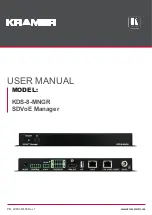
Chapter 2. Management, Reliability, Availability, and Serviceability
43
Service user interfaces
The service interface allows support personnel or the client to communicate with the service
support applications in a server by using a console, interface, or terminal. Delivering a clear,
concise view of available service applications, the service interface allows the support team to
manage system resources and service information in an efficient and effective way.
Applications that are available through the service interface are carefully configured and
placed to give service providers access to important service functions.
Various service interfaces are used depending on the state of the system and its operating
environment. Here are the primary service interfaces:
Service Indicator LEDs (See “Service Indicator LEDs” on page 41 and “Concurrent
maintenance” on page 42.)
Service processor
Service Interface
The service interface allows the client and the support personnel to communicate with the
service support applications in a server by using a browser. It delivers a clear, concise view of
available service applications. The service interface allows the support client to manage
system resources and service information in an efficient and effective way. Different service
interfaces are used depending on the state of the system, hypervisor, and operating
environment. Here are the primary service interfaces:
Service processor: Ethernet Service Network with IPMI Version 2.0
Service Indicator LEDs: System attention and system identification (front and back)
Host operating system: Command-line interface (CLI)
The service processor is a controller that is running its own operating system.
IBM Power Systems Firmware maintenance
The IBM Power Systems Client-Managed Licensed Internal Code is a methodology that you
can use to manage and install Licensed Internal Code updates on a Power Systems server
and its associated I/O adapters.
Firmware updates
System firmware is delivered as a release level or a service pack. Release levels support the
general availability (GA) of new functions or features, and new machine types or models.
Upgrading to a higher release level is disruptive to customer operations. These release levels
are supported by service packs. Service packs are intended to contain only firmware fixes
and not introduce new functions. A
service pack
is an update to an existing release level.
IBM is increasing its clients’ opportunity to stay on a given release level for longer periods.
Clients that want maximum stability can defer until there is a compelling reason to upgrade,
such as the following reasons:
A release level is approaching its end of service date (that is, it has been available for
about a year, and soon service will not be supported).
Move a system to a more standardized release level when there are multiple systems in
an environment with similar hardware.
A new release has a new function that is needed in the environment.
A scheduled maintenance action causes a platform restart, which provides an opportunity
to also upgrade to a new firmware release.
Summary of Contents for S822LC
Page 2: ......
Page 10: ...THIS PAGE INTENTIONALLY LEFT BLANK...
Page 14: ...xii IBM Power Systems S822LC for High Performance Computing...
Page 74: ...60 IBM Power Systems S822LC for High Performance Computing...
Page 78: ...64 IBM Power Systems S822LC for High Performance Computing...
Page 79: ......
Page 80: ...ibm com redbooks Printed in U S A Back cover ISBN REDP 5405 00...















































